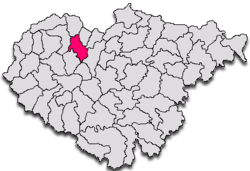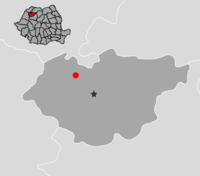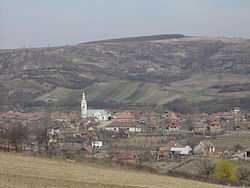Bocșa, Sălaj
| Bocşa Oláhbaksa | |
|---|---|
|
Greek Catolic Church in Bocşa, where the mausoleum of Simion Bărnuţiu is located. | |
 Bocşa within Sălaj County | |
 Bocşa Bocşa within Romania | |
| Coordinates: 47°17′41″N 22°54′49″E / 47.29472°N 22.91361°ECoordinates: 47°17′41″N 22°54′49″E / 47.29472°N 22.91361°E | |
| Country |
|
| County | Sălaj |
| Recorded | 1349 |
| Government | |
| • Mayor | Ioan Barou |
| Population (2001) | |
| • Total | 3,463 |
| Time zone | EET (UTC+2) |
| • Summer (DST) | EEST (UTC+3) |
| Prefix | +40 260 |

Bocşa (Hungarian: Oláhbaksa) is a commune located in the northwest of Transylvania, in Sălaj County, Romania. It is composed of four villages: Bocşa, Borla (Szilágyballa), Câmpia (Somlyómező) and Sălăjeni (Ököritó).
Tourism and sightseeing
In addition to the beautiful natural scenery, such as Dealul Măgurii, there are two buildings with historical value: the former building of the commune hall in Bocşa (1937–1938) and a house in Câmpia built in the 18th century.
The former building of the commune hall in Bocşa became the Simion Bărnuţiu memorial house in 1985. The memorial house is also a showcase of the history of Bocşa. In front of the museum is a bust of Bărnuţiu.
Another bust of Bărnuţiu (created by the artist Horea Flămându) was placed in the Central Park of Bocşa in 1967.
The brick church was consecrated in 1941. The remains of Bărnuţiu and those of a local Catholic clergyman, Alimpiu Barboloviciu, are placed in the church from Bocşa.
Geography
With a land area of 47.34 km2 (4000 ha), Bocşa is situated in the Zalău River Basin. The Zalău River flows through Bocşa. Bocşa village is situated at 18 km from Zalău city, and at 16 km from the projected Transylvania Motorway.
Demographics
According to the last census (2002), the total population of the commune counts 3463 inhabitants, of which 51.54% are Romanians, 39.79% Hungarians, 8.63% Romani and 0.04% are other nationalities.
Economy
The economy of the commune is primarily agricultural. It is known as an important wine producing area, with approx. 167 ha vine-lands. The wine of Borla is well-known even abroad.[1]
History
Bocşa was first mentioned in documents in 1349 under the name Villa Baxa. In 1854, its name became Olah-Baksa or Bocşa Română. Borla was first mentioned in 1341, Câmpia in 1427 and Sălăjeni 1430.
After the conquest of the region by the Habsburgs, the inhabitants of Bocşa became, in majority, Greek Catholic. Communist government imposed a return to the Orthodox faith and a brick church replaced the ancient wooden church. At the end of the 1930s, the wooden church was transported to the Village Museum in Bucharest.
One famous Bocşa native is the great scholar Simion Bărnuţiu, a historical figure and hero who fought for popular sovereignty in the 19th century. He was one of the leaders of the Transylvanian revolution in 1848–49. Simion Bărnuţiu contributed to the development of the philosophic, politic and legal way of thinking of his people. He had lectures for pupils and students and some of his main works are still timely.
The settlements from Neolithic, Dacian state and the early Feudal period were found at the archeological site of Pietriş.
In the western part of Bocșa, toward Lompirt, on the Zalău River Valley, was found a prehistoric settlement and a pre-Feudal one.
Villages
Borla
The first written source about the village dates back to 1341 and refers to it under the name of Barla. Allegedly Barla is an allusion to ‘barlang’ (i.e. cave), where inhabitants used to retreat from waves of Tatar invasions. Excavations, however, revealed that the area was populated already in the Bronze Era, and some artifacts are even dated back to the Neolithic Era. The Szilágy-prefix was assigned when the train station was built in 1913, referring to the county.
Around 1450 the village was the property of the Bishop of Várad (Oradea), who participated on the side of Hunyadi in the battle of Belgrade, and fell hostage to the Turks. Afterwards the village was owned mostly by the Bánffy family until the early 20th century.
Borla is inhabited mainly by Reformed ethnic Hungarians, although Baptists and Romanian Orthodox are present, as well as Roma and a few ethnic Romanians.
Local education has its roots in church-owned educational institutions, with written records as of 1852. The present school was built in 1970, mainly by local effort. The old school building is used as nursery school. Classes are held mainly in Hungarian, except for the Roma community, for which one aggregate class of the first elementary grades is maintained in Romanian. Afterwards pupils travel to the school in neighboring Bocşa.
Viticulture is the traditional occupation, with the soil allegedly more acidic than in other parts of the county (Sărmăşag and Şamşud), which produces a more mature and full tasting wine than its local competitors.
Politics
2012 election
The Bocşa Council, elected in the 2012 local government election, is made up of 11 councilors, with the following party composition: 6-Democratic Union of Hungarians in Romania, 6-Social Liberal Union, and 1-Democratic Party.[2]
| Party | Seats | 2012 Bocşa Council | ||||||
|---|---|---|---|---|---|---|---|---|
| Democratic Union of Hungarians in Romania | 6 | |||||||
| Social Liberal Union | 6 | |||||||
| Democratic Party | 1 | |||||||
2008 election
| Party | Seats | 2008 Bocşa Council | |||||
|---|---|---|---|---|---|---|---|
| Democratic Union of Hungarians in Romania | 5 | ||||||
| National Liberal Party | 5 | ||||||
| Democratic Party | 2 | ||||||
| Social Democratic Party | 1 | ||||||
2004 election
The mayor Ioan Barou was elected for the first time in 2004 local government election as a member of the National Liberal Party and re-elected in 2008 and 2012.
| Party | Seats | 2004 Bocşa Council | ||||
|---|---|---|---|---|---|---|
| Democratic Union of Hungarians in Romania | 4 | |||||
| Social Democratic Party | 4 | |||||
| National Liberal Party | 3 | |||||
| Democratic Party | 2 | |||||
Mayors
- Vasile Popiţiu (1872–1946) served as the mayor during the interwar period.
- Ioan Şamşudan was elected as the mayor in 1996 and 2000.
- Ioan Barou (b. February 12, 1975) was elected in 2004, 2008, and 2012.
Notable residents
- Simion Bărnuţiu
- Alimpiu Barboloviciu
Gallery
-

Museum, with bust of Simion Bărnuţiu in front
-

Train station
-

View of Borla village
Footnotes
- ↑ http://www.szilagyballa.com
- ↑ "Alegerile locale in Salaj, rezultate finale!". Magazinsalajean.ro. Retrieved 2014-03-17.
External links
- (Hungarian) Unofficial site about Borla village
| Wikimedia Commons has media related to Bocşa, Sălaj. |
.jpg)
